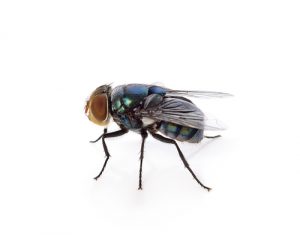“Fly Speck” Fungus
By Chris Williams on September 22, 2011.
Q. We just got new siding on our house last year. Now I see these round, black fly specks all over the siding on one side. They don’t wash off! What kind of fly left these and how do I get rid of it?
A. I suspect that it’s not a fly at all. Sounds like you’ve been the victim of artillery fungus! What looks like black fly specks are really the spores from a fungus that grows in old mulch. It’s called artillery fungus (or shotgun fungus) because it shoots its spores for quite a distance. You can confirm this diagnosis by looking for nearby shredded hardwood mulch that is damp and rotting—probably on the surface of foundation plantings on that side of the house. Infected wood mulch sometimes has a bleached appearance.
Artillery fungus, Sphaerobolus, makes its appearance in spring and fall when temperatures range between 50-68°F. The fungus develops in the mulch and the tiny fruiting bodies of the fungus shoot the spores as far as 20 feet onto any nearby surface: siding, windows, vehicles, decks, fences, or plants. The fungus directs the spores towards light, including light reflected from white surfaces. This is why the spores often end up on light-colored siding. The round, black spots that result are only about 1/10 inch in diameter, about the size of fly specks.
 While artillery fungus is mostly an outdoor problem, the spores can be found on walls and other surfaces indoors in certain cases: (1) if potted plants are top-dressed with hardwood mulch, or if (2) a potting soil is used that contains a large amount of wood product. Large indoor plantscapes, such as in shopping malls or office building lobbies, could have a problem with artillery fungus if hardwood mulch is used to cover sunken pots and groom the surface of beds.
While artillery fungus is mostly an outdoor problem, the spores can be found on walls and other surfaces indoors in certain cases: (1) if potted plants are top-dressed with hardwood mulch, or if (2) a potting soil is used that contains a large amount of wood product. Large indoor plantscapes, such as in shopping malls or office building lobbies, could have a problem with artillery fungus if hardwood mulch is used to cover sunken pots and groom the surface of beds.
The bad news (as you’ve discovered) is that the spores stick like tar and are almost impossible to remove. Repeated scrubbing and scraping may get them off but usually leaves a brown spot and can damage surfaces. Power washing does not work well either because the hot water and high pressure required to do the job can damage some siding. Spotted siding usually must be scraped, primed with a stain repellent, and repainted. You may have a problem getting your insurance company to pay for this work since most companies no longer cover mold damage.
There are things you can do, however, to prevent a reoccurrence on your siding. Rake up old hardwood mulch and replace it with either pine bark, cedar, redwood, or cypress mulch (these mulches seem to be resistant to the fungus), or add a synthetic mulch, or small stones around the foundation instead. For an easy fix, simply spreading pine bark mulch on top of the hardwood mulch can lessen the problem, as will adding fresh mulch on a regular basis to cover old mulch. Make sure you replace or cover old mulch in early spring before the April-May “launch date” of artillery fungus.
Artillery fungus is becoming more of a threat to the mulch industry since more wood waste is being recycled into mulch and the use of mulch in landscaping has increased. The complaints about artillery fungus have gone up in recent years. Mulch producers are worried that customers will switch to synthetic plastic or black pellet mulches instead. Artillery fungus is found everywhere in the U.S. except for some dry western areas. It’s a particular problem in New Jersey, Ohio, and Pennsylvania because it favors the type of wood available in these areas. The good news is that the impact of the fungus is all cosmetic, it is not a hazard in any way.